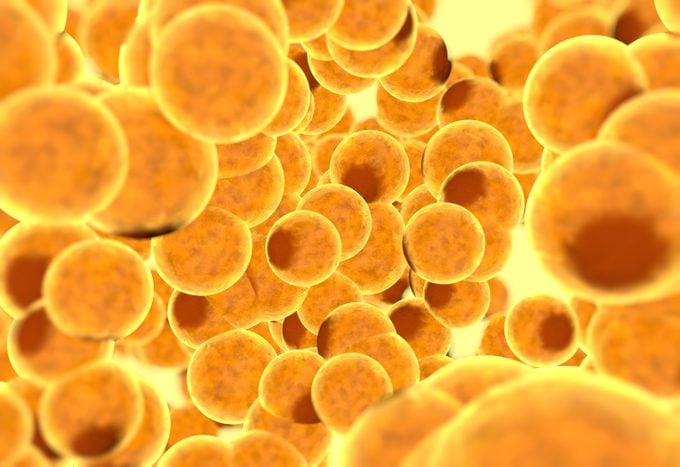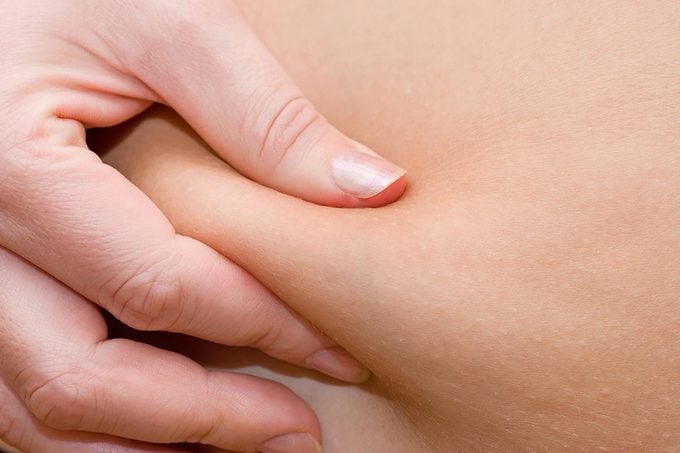13 Things You Need to Know About Body Fat
Updated: Jan. 12, 2020

There are several types of body fat, and some types, namely brown or beige fat, are actually good for you. Here are 13 things you need to know about body fat.
Here’s what you need to know about body fat
Fat tends to get a bad rap, and while being overweight or obese can increase your risk of certain diseases and conditions, there is more to this story. Not all fat is created equal—and some types are even good for us.
Fat wears several hats

Even though people tend to demonize fat, the stuff delivers some important health benefits. For starters, it cushions and protects your vital organs, including the kidneys, and helps keeps us warm. Fat also prevents us from starving because it acts as an energy reserve. “It’s unfortunate that we have such a pervasive antipathy about fat, as it’s a normal (and important) part of the body,” says Scott Kahan, MD, the director of the National Center for Weight and Wellness in Washington, DC.
Not all types of fat are the same
The most abundant type of body fat is white fat, explains Dr. Kahan. This is the type of fat we feel when we “pinch an inch” on our mid-section. “Its primary function is to store excess energy for later use,” he explains. “If you go on a diet or, for some reason, don’t have access to food, your body will take some stored energy from these adipose tissue cells to fuel the body.” This fat literally sustained our ancestors when hunting and gathering were the only ways to eat, and scarcity was common. (However, if you are looking to shed the stuff, here are 10 easy workouts that can help you burn fat.)
Fat cells have jobs
In addition to energy storage, white fat cells produce certain hormones, like leptin and adiponectin, Dr. Kahan says. Adiponectin improves the body’s sensitivity to insulin, which protects against type 2 diabetes, according to the Society for Endocrinology. Leptin is the hormone that tells you to stop eating when you are full, which helps maintain a normal weight.
Brown fat is different
So what is brown fat? It’s a second type of adipose or fat tissue found mainly in the neck region. “These cells are very different from run-of-the-mill white fat cells,” Dr. Kahan says. “Rather than store energy, brown fat cells burn it, thereby creating heat.” Brown fat helps infants regulate their body temperature; we tend to lose it as we age, and adults only have small amounts. “If we had more of it, we could burn off much more energy daily, which may help to regulate body weight,” says Dr. Kahan. Researchers are hunting for a way to increase brown fat or make white fat behave more like brown fat. Stay tuned.
Brown fat can be revved up
Cool and cold temperatures may help activate more brown fat cells, according to a study in Diabetes. In the small study, 5 young men slept in rooms of varying temps and the researchers found that mild cold (19º C, about 66º F) increased the men’s brown fat amount and activity by about 30 to 40 percent. When the men returned to sleeping in rooms that were warm (27º C; 81º F), however, their brown fat levels dropped back down to below what it was before the study started.
Coffee may boost brown fat
Drinking a cup of joe can stimulate brown fat, a 2019 study in Scientific Reports suggests. The researchers used a thermal imaging technique to trace the body’s brown fat reserves and found that it got hotter after participants drank a cup of coffee. This isn’t coffee’s only health benefit. Here are 7 things that happen to your body when you drink coffee every day.
Brown fat may ward off type 2 diabetes
Brown fat keeps blood sugar levels in check, according to a 2016 study in Cell Metabolism. When researchers measured brown fat and glucose, they found that individuals with more brown fat had smaller fluctuations in blood sugar. High blood sugar levels travel with diabetes—learn more about why blood sugar is so important.
There’s a third type of body fat
A so-called beige fat (a.k.a. brite fat) also burns off calories instead of storing them like white fat cells. Unlike brown fat, beige fat is the result of white fat that has “browned.” In a study in the International Journal of Obesity Supplements, the researchers suggest that the sympathetic nervous system may convert white fat cells into beige ones to produce body heat; while the process isn’t completely clear yet, the authors theorize that increasing the sympathetic nervous system’s supply of blood vessels to white fat tissue may aid in the browning process.
Location matters
When it comes to body fat, it’s location, location, location, notes Dr. Kahan. And belly fat isn’t the best location for extra weight. “Fat stored viscerally or around the inner organs like the liver and gut is generally more concerning because it is metabolically active [and] releases inflammatory chemicals and other molecules that can increase the risk of heart disease, liver disease, diabetes, and other health conditions.” In contrast, he says, fat that is stored in your arms, legs or hips tends to be fairly inactive. “It stores energy, but doesn’t typically do much to harm health.” If you’re looking to shed white body fat, time-restricted feeding, a type of intermittent fasting, could be helpful.
Body fat is linked to depression
If you are carrying around slightly more than 22 pounds of excess body fat, you may be more likely to be depressed—and the more extra weight, the greater your risk for depression. This is the main conclusion of a study by researchers from Aarhus University and Aarhus University Hospital in Denmark. It doesn’t matter where the extra fat is parked either, according to the study in Translational Psychiatry. While they don’t understand exactly how excess body fat is linked to depression, the researchers suspect the link may be the psychological consequences of obesity—things like negative body image and low self-esteem. Here are 15 science-backed ways to overcome depression naturally.
Body fat can affect brain health
Researchers are finding that body fat around your abdomen may be linked to reduced amounts of gray matter in your brain, according to a study in Neurology. Specifically, people with higher body mass indexes (BMI) and higher waist-to-hip ratios had less gray matter—the material in the brain that helps process new information—compared to their leaner counterparts. But the study authors can’t say whether body fat is the cause of these changes in the brain—or a result of them.
Fat cells can freeze to death
Fat cells are more sensitive to cold than and muscle and skin cells, explains Anne Chapas, MD, director of Union Square Laser Dermatology and Instructor of Dermatology at Mount Sinai Medical Center in New York. “When external cooling devices are applied to the skin they cause a process known as cryolipolysis which permanently kills that fat cells right below the skin,” she says. The body removes these damaged cells over a two-month period—and the fat doesn’t come back. Noninvasive body contouring devices such as CoolSculpting, which freezes fat cells, can be used to target white fat, she adds. You can learn more about CoolSculpting here.
Fat cells can melt away too
Heat can also be used to permanently eliminate fat cells, says Dr. Chapas. “Several in vitro studies have shown that heating fat cells above 40oC [104ºF] for a sustained amount of time can cause the fat cells to undergo programmed cell death,” she explains, “Heat can be generated from radiofrequency devices or laser sources. These damaged fat cells are eliminated from the body, she says. Liposuction can also get rid of fat cells permanently.


